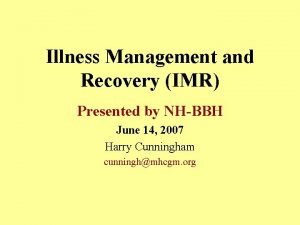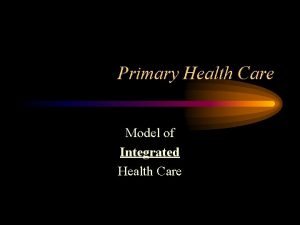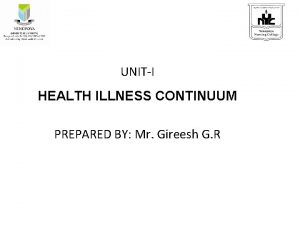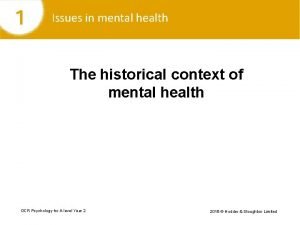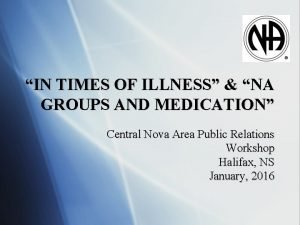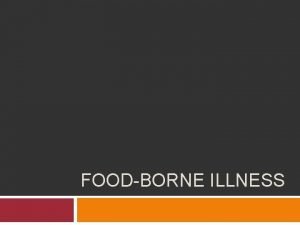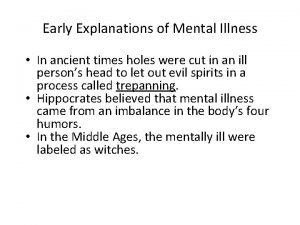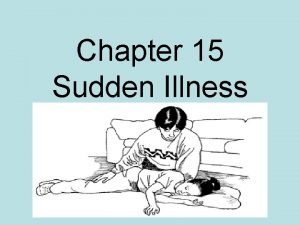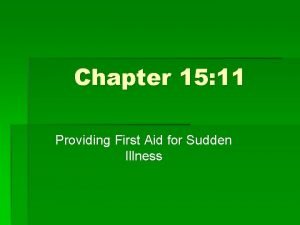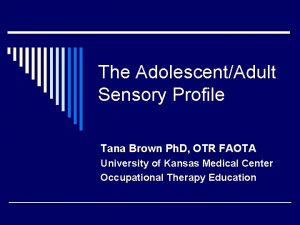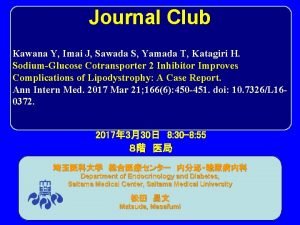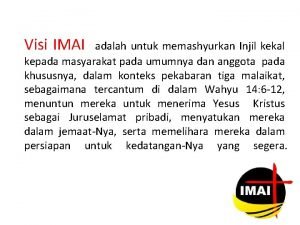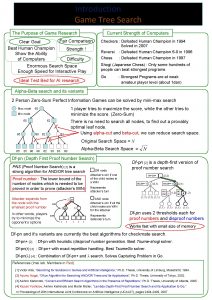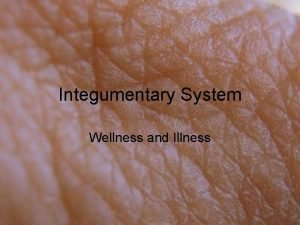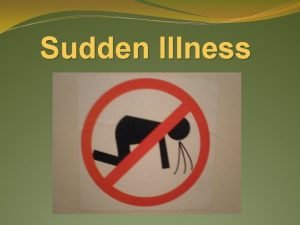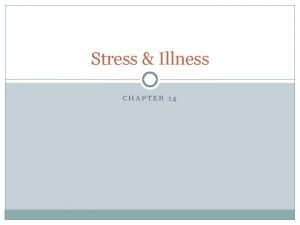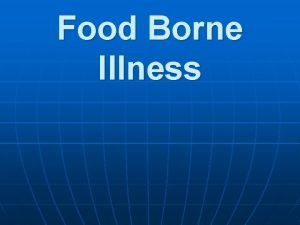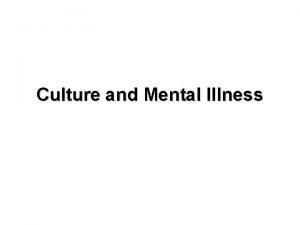Integrated Management of AdolescentAdult Illness IMAI A Primary























- Slides: 23

Integrated Management of Adolescent-Adult Illness (IMAI): A Primary Health Care Approach to TB-HIV Care in Low Resource Settings Dr Sandy Gove, IMAI Technical Coordinator WHO IMAI Technical Working Group 22 Departments and Regional Offices including: Stop TB HIV/AIDS Management of Non-Communicable Disease Child and Adolescent Health Service Provision Mental Health and Substance Dependence Evidence for Health Policy Roll Back Malaria AFRO Regional Office IMAI International Working Group Zimbabwe, Uganda, Zambia, many other institutions/organizations/individuals

IMAI Pregnancy IMPAC 10 Bir th ars Ye 5 Years 2 Months 1 Week IMCI Integrated Management of Pregnancy and Childbirth Integrated Management of Childhood Illness Integrated Management of Adolescent/Adult Illness

TB DOTS PAL HIV IMAI STI Integrated Content for Primary Health Care

TB-HIV within Integrated Management of Adolescent/Adult Illness (IMAI) · TB and HIV care integrated within primary health care · For first-level facility health workers in low resource settings · both district outpatient clinics and peripheral health centres · both rural and urban · Complements MD/senior clinician guidelines for ARV treatment and TB-HIV care • Integrates care and prevention

National and District Planning: TB, HIV, STI and other Programmes; General Medical Services Nurses District Health centres, clinics Community Inpatient Clinicians in outpatient clinics Peer educators/ support staff/ counselors Nurses Peer educators/ support staff/ counselors IMAI Home-based care: caregiver education in palliative care TB case detection TB and ARV treatment supporters Link with community organizations, NGOs

How IMAI can contribute to TB control Intensified TB case detection • Ask & observe for cough in all acute patients • Send sputums in acute pneumonia • Broader criteria--> special attention/referral if: – suspicious nodes – severe undernutrition or weight loss – abdominal pain – persistent fever • Consider TB: – on follow-up visits after acute care – at each HIV care visit – during home-based palliative care

How IMAI can contribute to TB control TB treatment closer to home • Contributes to continuing expansion of DOTS to enable first-level facilities to initiate treatment in smear + patients and monitor care • TB treatment supporters in the community • Effective training using MANAGEMENT OF TUBERCULOSIS: Training for Health Facility Staff Few IMAI additions (for nurses also trained in HIV and acute care): – – When to refer to clinician for consideration ART Cotrimoxazole prophylaxis and pyridoxine in all TB-HIV patients Treat peripheral neuropathy with amitriptyline Manage acute illness (using IMAI Acute Care)

IMAI Acute Care module • Care for both HIV+ and HIV- patients • When to suspect HIV and TB • HIV testing & counselling in context of clinical care (using lay counsellors) • Preventive interventions linked with all care • Enables the nurse to provide most acute care, as in IMCI • Same format as IMCI--> efficiencies in training, care, and clinic and district management

IMAI Acute Care includes care for: • • • pneumonia diarrhoea fever undernutrition and anaemia genito-urinary: STIs, UTIs, menstrual problems oral problems- candida, ulcers peripheral neuropathy, headaches, other neurological skin infections pyomyositis depression harmful alcohol use Integrated with preventive interventions

IMAI General Principles of Good Chronic Care Supports introduction of an effective approach to chronic care (lifelong care): · treatment partnership with the patient · respect for patient’s right to choose · emphasis on patient education, self-management, and active support for adherence (with reminders, treatment supporters. . . ) · team approach · inclusion of “expert patients”/peer educators and support staff on clinical team

IMAI HIV Care module · Introduction of an efficient approach to chronic care · With or without ARV treatment · Prophylaxis- cotrimoxazole, INH, fluconazole · Patient education and psychosocial support · Adherence preparation and support · Clinical monitoring • Support for disclosure & other interventions to prevent transmission

IMAI HIV Care module ȏ Focus on nurses and peer (lay)educators/support staff- working in a clinical team with the clinician ȏ Close collaboration with community volunteers and organizations ɋ Complements ARV & TB-HIV clinician guidelines ɋ Based on general principles of good chronic care (applicable in other chronic diseases) ɋ For use in range of facilities to allow scale up: ɋ ɋ Government Private NGO Mission

IMAI Palliative Care: Symptom Management and End-of-Life Care Palliative Care Guidelines for clinical management, home care recommendations, back-up to home-based care • Caregiver Education Booklet to • • prepare patients, families and community-based carers to provide effective home care • Line drawings • Locally adapted • • • Essential, quality palliative care within home care To improve management of pain and other symptoms within homebased care Support oral morphine use at home Both medical and non-medical interventions Simplified, standardized approach Public health approach- capable of achieving wide coverage

Adolescent Job Aid • How to make the facility and health worker adolescent-friendly, to allow access • Special considerations in treating adolescents • For use with IMAI, IMPAC (pregnancy guidelines), Family Planning, STI guidelines • Essential to allow integrated adolescent and adult guidelines

IMAI: tools for rapid expansion of TB-HIV care Generic tools for country adaptation and implementation: · simplified evidence-based guidelines for health workers · simplified job aids for lay staff · training materials · cards/booklets for patients and community carers · materials to support country adaptation and implementation

IMAI: tools for rapid expansion of TB-HIV care Several alternative training methods are needed with: • Efficient methods � skill stations � video presentation of cases and skills � combine initial distance learning with clinical practice and short workshops or on-site training � build on IMCI skills for acute care training • Early introduction into preservice education

Shift responsibility for much outpatient adult care to nurses and other first-level facility health workers Expand staff: involve lay counsellors and “expert patients” on clinical team Involve community in case detection and care delivery Preserve staff by providing ARV treatment Aim: rapid expansion of human resources for TBHIV care and prevention while providing skills and clinic capacity to manage other acute and chronic illnesses

Status of IMAI modules relevant to TB-HIV care • When ready for country adaptation and fieldtesting/phased implementation with close monitoring : – HIV Care Now – Palliative Care Now – Caregiver Education Booklet Now – General Principles of Good Chronic Care August – Acute care- in validation studies October • Collaborators with resources needed: – further review and expert input – another acute care validation study site – fieldtesting and early implementation with close monitoringworking with IMAI team • Few IMAI additions (for use by nurses trained in HIV Care) to the TB training materials- for review.

Further development of IMAI • Iterative process • Need further input from as many low resource settings as possible- both by review and fieldtesting • Further guideline simplification- needs to be evidence-based – hope to eliminate clinical signs from acute care algorithm based on validation results • Need help in the development of effective and efficient training materials

IMAI country adaptation will include rapid ethnographic methods to culturally modify interventions: • to improve adherence (by understanding beliefs about medications) • to explore how the association of TB with HIV affects case detection • to renew and expand prevention efforts linked with new availability of HIV treatments • to tailor more effective communication methods

IMAI modules of less relevance to TB-HIV control • Quick Check and • Diabetes Emergency Treatments • Integrated approach to • Brief interventions for cardiovascular disease key risk factors • RF/RHD secondary • Smoking prophylaxis • Poor diet • Epilepsy • Physical inactivity • Leprosy • Harmful alcohol use • Asthma • COPD …. . .

Acute Care TB c ase d Poor diet r to ref e to hen , w yla ph Diabetes Care, other chronic diseases xis pr + ob lem s Case detection an cli nic i HI V ion cu te tes tin g: ect se det ea ea Long but timelimited pro Physical Inactivity ag IMAI additions to TB Reference Booklet HIV Care CT X Smoking an TB Care- ion se cr etect Ca In M Harmful Alcohol Use Acute Symptom management End-of-life care Chronic Care and Risk Reduction: general principles of good chronic care Palliative Care Chronic

First-level facility care: outpatient or peripheral health centres TB Medical HIV care for testing sick within adolescent/ clinical adult care VCT (freestanding) FP Home-based care Antenatal care: recruited via PMTCT activities Labour and delivery Severely ill patients in ED, inpatient Special FP, STI, HIV, TB clinics
 Numero imai
Numero imai Nhbbh
Nhbbh Oakwood integrated primary school
Oakwood integrated primary school Integrated primary health care model
Integrated primary health care model Yellow magenta and cyan are the ___
Yellow magenta and cyan are the ___ Conclusion of mental health
Conclusion of mental health History of present illness example
History of present illness example Historical views of mental illness psychology ocr
Historical views of mental illness psychology ocr Food borne illness poster
Food borne illness poster Illness in recovery na
Illness in recovery na Foodborne illness vocabulary
Foodborne illness vocabulary Fair housing act mental illness
Fair housing act mental illness Foodborne illness
Foodborne illness Mental illness in ancient times
Mental illness in ancient times Eudemonistic model
Eudemonistic model Stages of heat illness
Stages of heat illness Chapter 20 mental health and mental illness
Chapter 20 mental health and mental illness Axis 1 and axis 2 disorders
Axis 1 and axis 2 disorders Chapter 17 providing first aid
Chapter 17 providing first aid Name 5 sudden illness.
Name 5 sudden illness. Chapter 17:11 providing first aid for sudden illness
Chapter 17:11 providing first aid for sudden illness Mark rothko mental illness
Mark rothko mental illness Patient chief complaint
Patient chief complaint Mike mazzalongo illness
Mike mazzalongo illness

